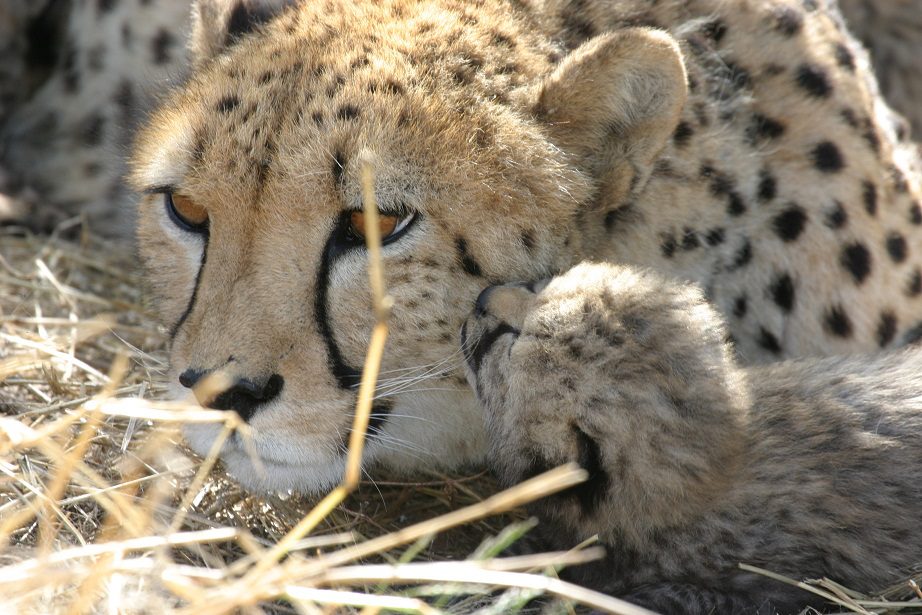Camping along the Trans-Caprivi
April 18, 2013Cold fronts snapping at heels of summer
April 19, 2013By Jana-Mari Smith
The hard work by the folks of AfriCat paid of this week when a rehabilitated cheetah gave birth to three cubs on April 16th in the wild.
This was the first time a rehabilitated cheetah had successfully carried cubs to term, since Okonjima kick started their Cheetah Rehabilitation programme in November 2000.
Staff at the nature reserve did not mince their words or excitement over the historical event.
“We are not sure how to express the surprise, joy and utter sense of relief after many hours, days, weeks, months and years of hard work – finally paying off!”
New mum “Dizzy” originally came to the AfriCat foundation’s cheetah rehabilitation programme after she was caught trying to survive on her own in the wild at eight months old.
She was taken to the Okonjima Nature Reserve, where AfriCat runs their programme, and introduced to four other orphans of roughly the same age as her.
On June 1 2012, Dizzy was released together with other rehabilitated cheetahs into the 20 000 hectare Okonjima Nature reserve, marking her re-entry into the wild.
From the start, Dizzy demonstrated a keen sense of survival in the wild. Unlike the other cheetahs that were released at the same time, Dizzy adapted rapidly to life in the wild.
She was seen mating with another successfully rehabilitated male cheetah in early January 2013.
AfriCat staff first saw the young cubs on Tuesday, and it could be that they were already born the night before.
AfriCat’s Cheetah Rehabilitation project was initiated to give some of our captive cheetahs an opportunity to return to their natural environment. Although hunting carnivores is instinctive, many of the cheetahs at AfriCat lack experience due to being orphaned or removed from the wild at an early age.
This inexperience, as well as their conditioning to captivity, makes these animals unsuitable for release on farmland. The cheetahs (usually a coalition of brothers and sisters) are fitted with radio-collars before their release into the camp so that their welfare and progress can be closely monitored.
Once they can prove that they can hunt for themselves and cope on their own, they can be relocated to a private game reserve, where their progress will continue to be monitored. Rehabilitated cheetahs are not released on farmland.
Situated halfway between the capital Windhoek and the Etosha National Park, the 22 000 hectare Okonjima Game Reserve has some of the best accommodation in Namibia, but the highlight has to be the cheetah and leopard safaris.
Namibian safaris are truly wonderful and as The AfriCat Foundation rehabilitates cheetahs, wild dogs hyaenas and leopards, there are opportunities to see these beautiful carnivores in their natural environment.
All photos courtesy of ©Okonjima and AfriCat
Cheetah fast facts courtesy of AfriCat and Okonjima
Acinonyx jubatus
- A ‘Rehabilitated Cheetah’ is an orphaned cheetah, that has NOT been hand-raised, but has been in captivity from a cub to adulthood, and is now hunting on its own and been given a second chance to return to the wild.
- It is important to remember that AfriCat’s cheetah rehabilitation programme was initiated to give some of our captive cheetahs an opportunity to return to their natural environment. Although hunting in carnivores is instinctive, many of the cheetahs at AfriCat lack experience due to being orphaned or removed from the wild at an early age
- All the rehabilitated cheetahs are monitored daily by radio-tracking them on foot and guests can participate in the tracking of these rehabilitated cheetahs on our “Cheetah Tracking Trail”
- Besides giving orphaned cheetahs a chance to return to the wild, the success of this project provides other substantial benefits. It gives us the opportunity to assess whether rehabilitation is a successful means of conserving an endangered population and also allows for the number of cheetahs in captivity to be reduced.
- Shoulder height:
- Male 79,62cm
- Female 77,71cm
- Male 79,62cm
- Length (tip of nose to base of tail):
- Male 132,57cm
- Female 127.48cm
- Male 132,57cm
- Base of tail to end of tail:
- Male 77.35
- Female 73.73
- Male 77.35
- Weight:
- Male 46,25kg
- Female 39,40kg
- Male 46,25kg
- Habitat: Cheetahs are found in a wide range of habitats. It is generally accepted that they are diurnal but have also been observed hunting on nights when there is sufficient moonlight.
- Gestation: 90 – 95 days
- Diet: A carnivorous species. Preys on medium size antelope, guinea fowl, hares etc – even jackal at times. Prey is run down at considerable speed over short distances and bowled over by having the hind legs knocked out from under it. Death is brought about by strangulation. It will not eat carrion or anything that has not been freshly killed. Hunting is aided by excellent sight.






1 Comment
Wonderful, wonderful news!!! As a former visitor to AfriCat and a lover, of course, of all those gorgeous cats, I really appreciated this story. Keep ’em coming!